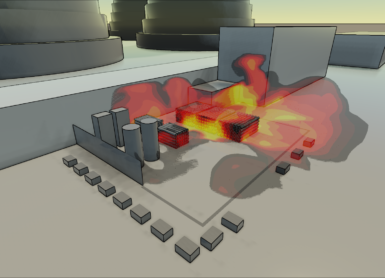
Over recent years, there has been a continued steady increase in the popularity of hydrogen as an alternative fuel, which has, in turn, led to a rapid increase in hydrogen handling and storage facilities worldwide.
Although hydrogen is a clean-burning fuel, it has many explosible characteristics which differ significantly from conventional (often hydrocarbon-based) fuels. In certain circumstances, the explosion overpressure generated from an ignited event can cause very severe damage to personnel, equipment, and buildings within the surrounding area.
It is therefore important that these characteristics are taken into consideration when designing hydrogen bulk storage areas to ensure suitable and sufficient risk reduction measures are implemented, in line with the principle of ALARP (As Low As Reasonably Practicable).
Using our flagship CFD modelling tool FLACS-CFD, Gexcon conducted several case studies on real facilities looking at the design of bulk storage areas in terms of safety during an ignited event, using relevant standards and documentation for guidance.
However, due to the output of the modelling scenarios, questions are being raised as to whether safety distances recommended within these publications could be underpredicted in some cases.
Gexcon UK FLACS Technical Lead Pablo Giacopinelli explains the motivation behind the investigation of this topic
‘’As engineers, we tend to follow standards and documentation based on best practices and past experiences to help ensure the results we predict are accurate. By using advanced technologies and tools such as FLACS–CFD, we are able to gain a better insight into real-life consequences associated with hazardous scenarios” he commented.
”During these studies, we investigated the maximum overpressures, resultant flame paths, and likelihood of deflagration to detonation transition (DDT) occurring. We did this by considering a range of gas clouds produced from leaks in the hydrogen storage and then modelled the consequences following the ignition of these clouds.
“By conducting dispersion and ventilation modelling we were able to gather a better understanding of the expected hydrogen cloud size, followed by several explosion simulation scenarios to ascertain the overpressures within and around the hydrogen storage area following an ignited event.
“Perhaps surprisingly, we were seeing that despite dramatic changes in the shape and size of the gas clouds, the overpressures and consequences of an explosion were still relatively high. This could be associated with the more reactive properties of hydrogen compared to other energy sources such as natural gas.
“The consequences suggested by the modelling appear to give rise to larger safety distances than those specified in the existing standards. The under-predicted safety distances could result in inadequate separation distances and con-conservative designs of areas’’.
The next steps for hydrogen safety studies
Asking Pablo about his thoughts on the safety aspects of designing hydrogen bulk storage areas, he said.
’’The aspect of the preliminary results we are seeing should bring great interest and I would encourage collaboration between organisations and regulators to conduct further investigations and consider the implementation of updates to regulations and standards surrounding hydrogen safety’’.
Would you like to learn more about this topic?
Watch a webinar where you will be presented with an investigation of the discrepancies between the currently available guidance and the results from our case study on safety distances for hydrogen application.
Do you like what you read?
Get the latest trends in the field of process safety management straight to your inbox, and enhance your skills through knowledge sharing from industry experts.


